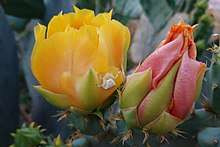Thomisus onustus
Thomisus onustus is a crab spider species in the genus Thomisus belonging to the family Thomisidae.
| Thomisus onustus | |
|---|---|
_with_prey_nettle_tree_butterfly_(Libythea_celtis).jpg) | |
| with prey nettle tree butterfly (Libythea celtis) on spearmint (Mentha spicata), Pirin National Park, Bulgaria | |
| Scientific classification | |
| Kingdom: | Animalia |
| Phylum: | Arthropoda |
| Subphylum: | Chelicerata |
| Class: | Arachnida |
| Order: | Araneae |
| Infraorder: | Araneomorphae |
| Family: | Thomisidae |
| Genus: | Thomisus |
| Species: | T. onustus |
| Binomial name | |
| Thomisus onustus Walckenaer, 1805[1] | |
| Subspecies[2] | |
|
T. o. meridionalis Strand, 1907 | |
Description
This species shows sexual dimorphism both in size and coloration. The adult males reach a body length of only 2–4 millimetres (0.079–0.157 in), while females are 6–7 millimetres (0.24–0.28 in) long. In males, the basic colour of the prosoma varies from yellow brown to dark brown, the opisthosoma may be yellow and green or brown. Females are very variable in colour, their basic colour can be white, yellow pale brown or pink, sometimes with additional shades of red. This species is characterized by the prominent rear corners of the opisthosoma.
Prey
Like other species of the family Thomisidae these crab spiders do not make a web, but wait in ambush for their prey on flowers. The spiders are disguised by assuming the same colour as the flower, fooling both insect and bird predators. The prey consists of flower-visiting insects of all species, such as hover flies, bees, wasps, butterflies or beetles, which are often several times larger than the spider. They take their prey with two powerful and highly enlarged front leg pairs and usually kill them by biting on the back of their neck. Emerging spiderlings of Thomisus onustus may feed on pollen or nectar when insect prey is lacking.
Reproduction
Mating takes place mainly in June. The male climbs onto the back of the female to copulate. Finally, the male leaves the female. The female during the entire mating is completely passive and does not show any aggressive behaviour.
Distribution and habitat
It has a Palearctic distribution, being found from Great Britain and Portugal in the west to Japan in the east.[1] It is present in most countries of Europe, but is absent in Iceland, Ireland, Norway, Denmark and Finland, and it has also been seen in Iraq and Egypt. Its north–south distribution extends from Sweden to South Africa and from Siberia to Central Java, including temperate and tropical ecozones. These spiders prefer warm temperatures, frost-free areas, dry and sandy habitats with high solar radiation and dry grasslands.
Gallery
 Feeding on a bee a few minutes after capture
Feeding on a bee a few minutes after capture- Thomisus onustus hunting Apis mellifera
 Thomisus onustus capturing a bee
Thomisus onustus capturing a bee- Male
 Female
Female Thomisus onustus hunting Apis mellifera
Thomisus onustus hunting Apis mellifera Eating a fly
Eating a fly
 Camouflaged by homochromy with an anthemis flower
Camouflaged by homochromy with an anthemis flower
See also
References
- "Taxon details Thomisus onustus Walckenaer, 1805", World Spider Catalog, Natural History Museum Bern, retrieved 2017-06-29
- "Taxon details Thomisus onustus meridionalis Strand, 1907", World Spider Catalog, Natural History Museum Bern, retrieved 2017-06-29
- Levy, Gershom (1970), "The life cycle of Thomisus onustus (Thomisidae: Araneae) and outlines for the classification of the life histories of spiders", Journal of Zoology, 160 (4): 523–536, doi:10.1111/j.1469-7998.1970.tb03095.x
- Théry, Marc & Casas, Jérôme (2002), "Predator and prey views of spider camouflage" (PDF), Nature, 415: 133, doi:10.1038/415133a, archived (PDF) from the original on 2017-06-29, retrieved 2017-06-29
- Vogelie, A. & Greissl, R. (1989), "Survival strategies of the crab spider Thomisus onustus Walckenaer 1806 (Chelicerata, Arachnida, Thomisidae)", Oecologia, 80 (4): 513–515, doi:10.1007/bf00380075
External links
| Wikispecies has information related to Thomisus onustus |
| Wikimedia Commons has media related to Thomisus onustus. |